Ren Li
School of Information Science and Engineering, Chongqing Jiaotong University
Single View Garment Reconstruction Using Diffusion Mapping Via Pattern Coordinates
Apr 11, 2025Abstract:Reconstructing 3D clothed humans from images is fundamental to applications like virtual try-on, avatar creation, and mixed reality. While recent advances have enhanced human body recovery, accurate reconstruction of garment geometry -- especially for loose-fitting clothing -- remains an open challenge. We present a novel method for high-fidelity 3D garment reconstruction from single images that bridges 2D and 3D representations. Our approach combines Implicit Sewing Patterns (ISP) with a generative diffusion model to learn rich garment shape priors in a 2D UV space. A key innovation is our mapping model that establishes correspondences between 2D image pixels, UV pattern coordinates, and 3D geometry, enabling joint optimization of both 3D garment meshes and the corresponding 2D patterns by aligning learned priors with image observations. Despite training exclusively on synthetically simulated cloth data, our method generalizes effectively to real-world images, outperforming existing approaches on both tight- and loose-fitting garments. The reconstructed garments maintain physical plausibility while capturing fine geometric details, enabling downstream applications including garment retargeting and texture manipulation.
Counting Stacked Objects from Multi-View Images
Nov 28, 2024


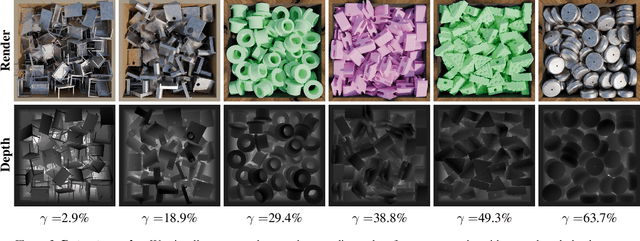
Abstract:Visual object counting is a fundamental computer vision task underpinning numerous real-world applications, from cell counting in biomedicine to traffic and wildlife monitoring. However, existing methods struggle to handle the challenge of stacked 3D objects in which most objects are hidden by those above them. To address this important yet underexplored problem, we propose a novel 3D counting approach that decomposes the task into two complementary subproblems - estimating the 3D geometry of the object stack and the occupancy ratio from multi-view images. By combining geometric reconstruction and deep learning-based depth analysis, our method can accurately count identical objects within containers, even when they are irregularly stacked. We validate our 3D Counting pipeline on diverse real-world and large-scale synthetic datasets, which we will release publicly to facilitate further research.
DiscoNeRF: Class-Agnostic Object Field for 3D Object Discovery
Aug 19, 2024


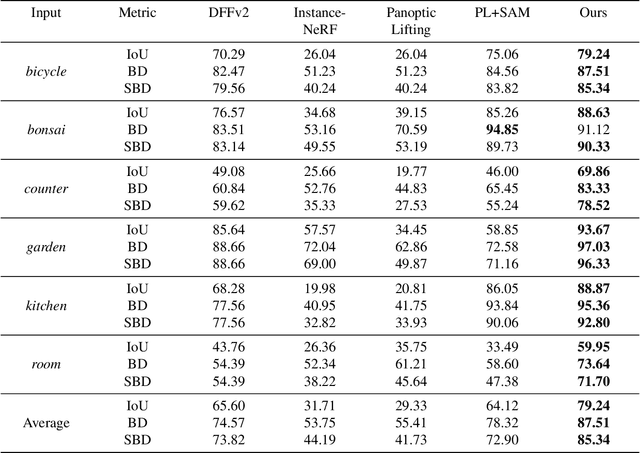
Abstract:Neural Radiance Fields (NeRFs) have become a powerful tool for modeling 3D scenes from multiple images. However, NeRFs remain difficult to segment into semantically meaningful regions. Previous approaches to 3D segmentation of NeRFs either require user interaction to isolate a single object, or they rely on 2D semantic masks with a limited number of classes for supervision. As a consequence, they generalize poorly to class-agnostic masks automatically generated in real scenes. This is attributable to the ambiguity arising from zero-shot segmentation, yielding inconsistent masks across views. In contrast, we propose a method that is robust to inconsistent segmentations and successfully decomposes the scene into a set of objects of any class. By introducing a limited number of competing object slots against which masks are matched, a meaningful object representation emerges that best explains the 2D supervision and minimizes an additional regularization term. Our experiments demonstrate the ability of our method to generate 3D panoptic segmentations on complex scenes, and extract high-quality 3D assets from NeRFs that can then be used in virtual 3D environments.
Reconstruction of Manipulated Garment with Guided Deformation Prior
May 17, 2024Abstract:Modeling the shape of garments has received much attention, but most existing approaches assume the garments to be worn by someone, which constrains the range of shapes they can assume. In this work, we address shape recovery when garments are being manipulated instead of worn, which gives rise to an even larger range of possible shapes. To this end, we leverage the implicit sewing patterns (ISP) model for garment modeling and extend it by adding a diffusion-based deformation prior to represent these shapes. To recover 3D garment shapes from incomplete 3D point clouds acquired when the garment is folded, we map the points to UV space, in which our priors are learned, to produce partial UV maps, and then fit the priors to recover complete UV maps and 2D to 3D mappings. Experimental results demonstrate the superior reconstruction accuracy of our method compared to previous ones, especially when dealing with large non-rigid deformations arising from the manipulations.
Garment Recovery with Shape and Deformation Priors
Nov 17, 2023



Abstract:While modeling people wearing tight-fitting clothing has made great strides in recent years, loose-fitting clothing remains a challenge. We propose a method that delivers realistic garment models from real-world images, regardless of garment shape or deformation. To this end, we introduce a fitting approach that utilizes shape and deformation priors learned from synthetic data to accurately capture garment shapes and deformations, including large ones. Not only does our approach recover the garment geometry accurately, it also yields models that can be directly used by downstream applications such as animation and simulation.
ISP: Multi-Layered Garment Draping with Implicit Sewing Patterns
May 23, 2023



Abstract:Many approaches to draping individual garments on human body models are realistic, fast, and yield outputs that are differentiable with respect to the body shape on which they are draped. However, none of them can handle multi-layered clothing, which is prevalent in everyday dress. In this paper, we introduce a parametric garment representation model that can. As in models used by clothing designers, each garment consists of individual 2D panels. Their 2D shape is defined by a Signed Distance Function and 3D shape by a 2D to 3D mapping. The 2D parameterization enables easy detection of potential collisions and the 3D parameterization handles complex shapes effectively. We show that this combination is faster and yields higher quality reconstructions than purely implicit surface representations, and makes the recovery of layered garments from images possible thanks to its differentiability. Furthermore, it supports rapid editing of garment shapes and texture by modifying individual 2D panels.
DrapeNet: Generating Garments and Draping them with Self-Supervision
Dec 07, 2022



Abstract:Recent approaches to drape garments quickly over arbitrary human bodies leverage self-supervision to eliminate the need for large training sets. However, they are designed to train one network per clothing item, which severely limits their generalization abilities. In our work, we rely on self-supervision to train a single network to drape multiple garments. This is achieved by predicting a 3D deformation field conditioned on the latent codes of a generative network, which models garments as unsigned distance fields. Our pipeline can generate and drape previously unseen garments of any topology, whose shape can be edited by manipulating their latent codes. Being fully differentiable, our formulation makes it possible to recover accurate 3D models of garments from partial observations -- images or 3D scans -- via gradient descent. Our code will be made publicly available.
DIG: Draping Implicit Garment over the Human Body
Sep 24, 2022


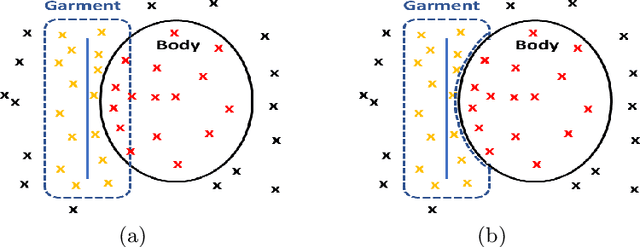
Abstract:Existing data-driven methods for draping garments over human bodies, despite being effective, cannot handle garments of arbitrary topology and are typically not end-to-end differentiable. To address these limitations, we propose an end-to-end differentiable pipeline that represents garments using implicit surfaces and learns a skinning field conditioned on shape and pose parameters of an articulated body model. To limit body-garment interpenetrations and artifacts, we propose an interpenetration-aware pre-processing strategy of training data and a novel training loss that penalizes self-intersections while draping garments. We demonstrate that our method yields more accurate results for garment reconstruction and deformation with respect to state of the art methods. Furthermore, we show that our method, thanks to its end-to-end differentiability, allows to recover body and garments parameters jointly from image observations, something that previous work could not do.
Is There More Pattern in Knowledge Graph? Exploring Proximity Pattern for Knowledge Graph Embedding
Oct 02, 2021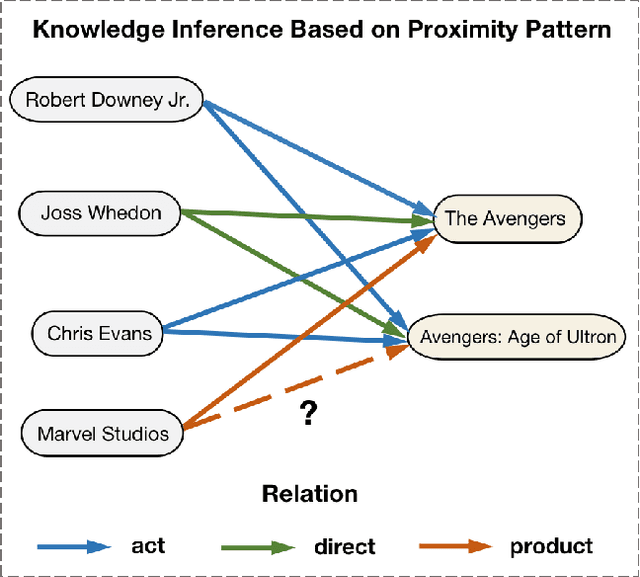
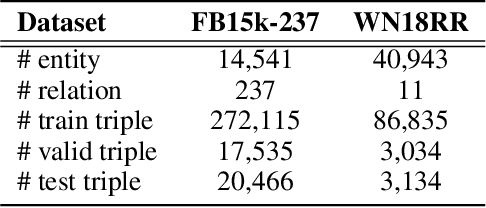
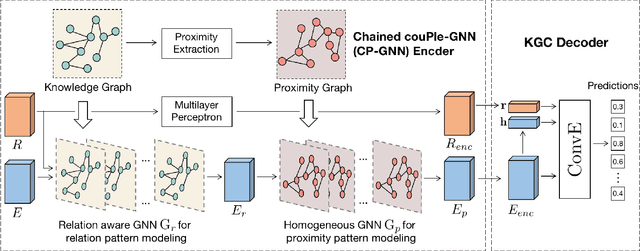
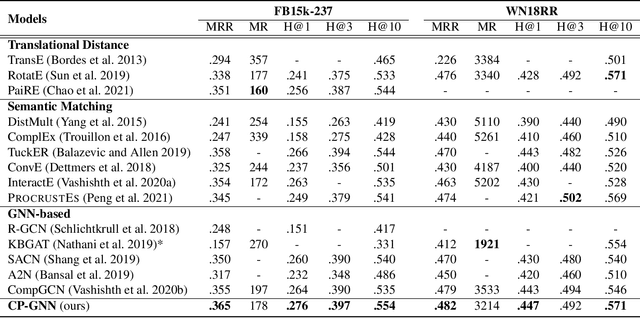
Abstract:Modeling of relation pattern is the core focus of previous Knowledge Graph Embedding works, which represents how one entity is related to another semantically by some explicit relation. However, there is a more natural and intuitive relevancy among entities being always ignored, which is that how one entity is close to another semantically, without the consideration of any explicit relation. We name such semantic phenomenon in knowledge graph as proximity pattern. In this work, we explore the problem of how to define and represent proximity pattern, and how it can be utilized to help knowledge graph embedding. Firstly, we define the proximity of any two entities according to their statistically shared queries, then we construct a derived graph structure and represent the proximity pattern from global view. Moreover, with the original knowledge graph, we design a Chained couPle-GNN (CP-GNN) architecture to deeply merge the two patterns (graphs) together, which can encode a more comprehensive knowledge embedding. Being evaluated on FB15k-237 and WN18RR datasets, CP-GNN achieves state-of-the-art results for Knowledge Graph Completion task, and can especially boost the modeling capacity for complex queries that contain multiple answer entities, proving the effectiveness of introduced proximity pattern.
How Does Knowledge Graph Embedding Extrapolate to Unseen Data: a Semantic Evidence View
Sep 24, 2021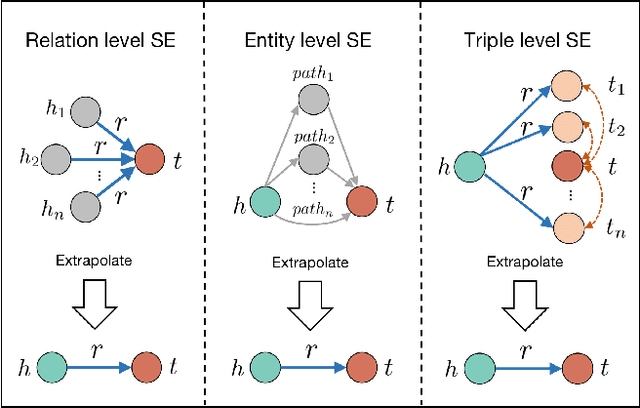
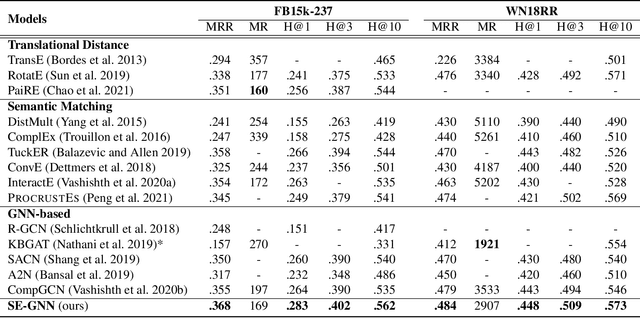
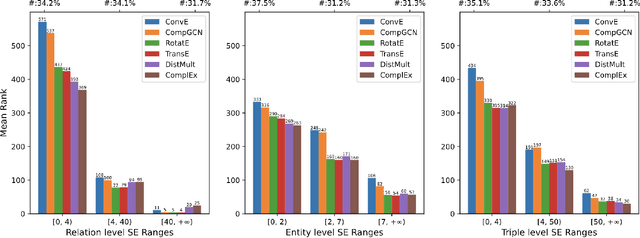
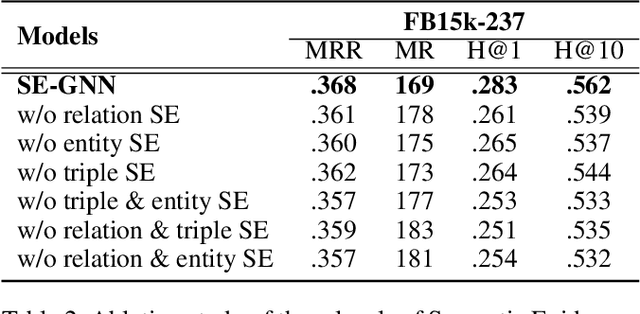
Abstract:Knowledge Graph Embedding (KGE) aims to learn representations for entities and relations. Most KGE models have gained great success, especially on extrapolation scenarios. Specifically, given an unseen triple (h, r, t), a trained model can still correctly predict t from (h, r, ?), or h from (?, r, t), such extrapolation ability is impressive. However, most existing KGE works focus on the design of delicate triple modeling function, which mainly tell us how to measure the plausibility of observed triples, but we have limited understanding of why the methods can extrapolate to unseen data, and what are the important factors to help KGE extrapolate. Therefore in this work, we attempt to, from a data relevant view, study KGE extrapolation of two problems: 1. How does KGE extrapolate to unseen data? 2. How to design the KGE model with better extrapolation ability? For the problem 1, we first discuss the impact factors for extrapolation and from relation, entity and triple level respectively, propose three Semantic Evidences (SEs), which can be observed from training set and provide important semantic information for extrapolation to unseen data. Then we verify the effectiveness of SEs through extensive experiments on several typical KGE methods, and demonstrate that SEs serve as an important role for understanding the extrapolation ability of KGE. For the problem 2, to make better use of the SE information for more extrapolative knowledge representation, we propose a novel GNN-based KGE model, called Semantic Evidence aware Graph Neural Network (SE-GNN). Finally, through extensive experiments on FB15k-237 and WN18RR datasets, we show that SE-GNN achieves state-of-the-art performance on Knowledge Graph Completion task and perform a better extrapolation ability.
 Add to Chrome
Add to Chrome Add to Firefox
Add to Firefox Add to Edge
Add to Edge